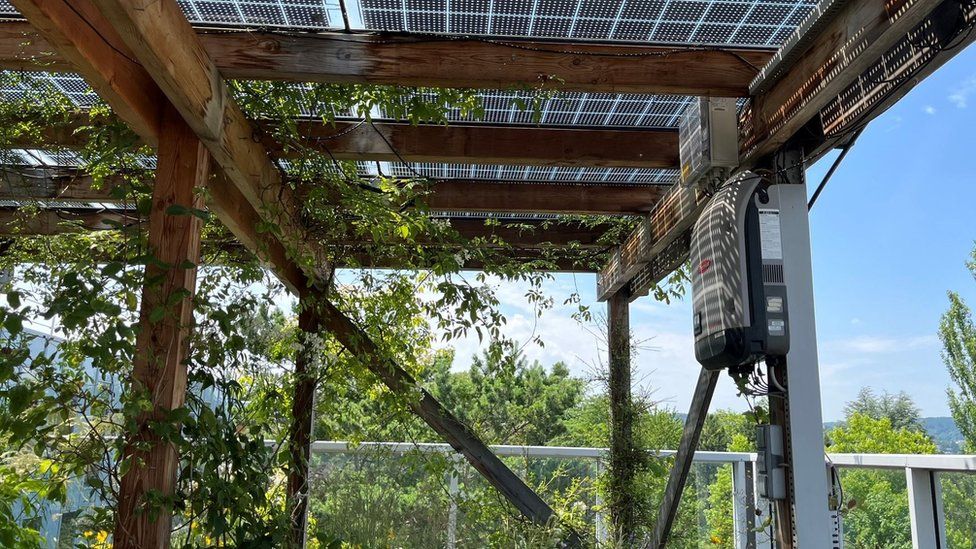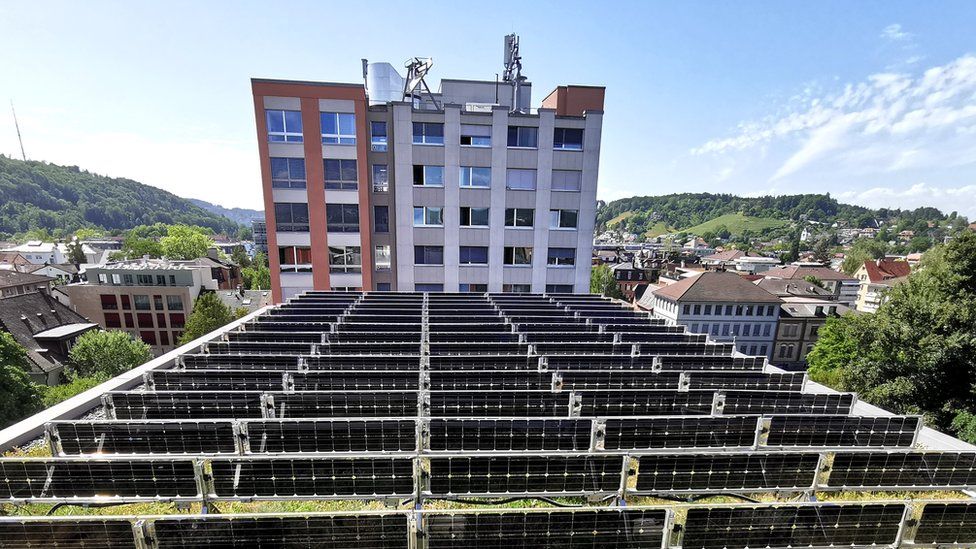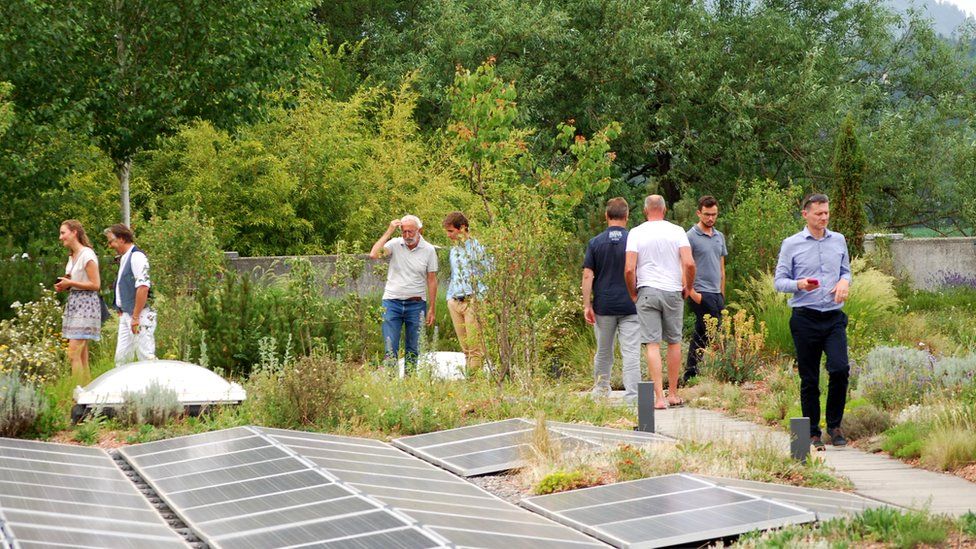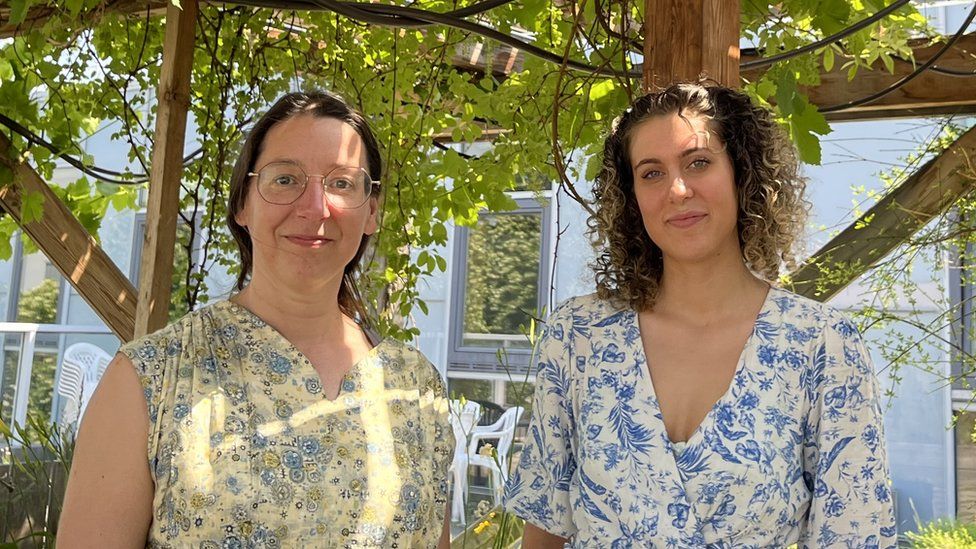Urban oases combine roof gardens and solar panels

I’m on a rooftop in Vienna. It’s a warm day but around me students work and chat in comfort, shaded by solar panels amid lots of plants.
The garden feels like an oasis amidst Vienna’s densely packed buildings.
It’s a demonstration project by Vienna’s University of Natural Resources and Life Sciences (BOKU), to show how a green roof can be combined with solar panels while preserving the feel of a garden.
In this case the solar panels are suspended 2m above the garden on a pergola. The semi-translucent panels allow light to reach the garden beneath, while still providing shade to the people sitting below.
Such gardens are valuable in cities where open space is at a premium and a green roof is more than just a flat roof with a few pot plants.
They have several layers of materials, providing sealing, drainage, filtration, soil and vegetation. The benefits are abundant: they can cool roof surfaces, retain rainwater, attract varied animal species, and of course create a more pleasant atmosphere.
Some are walkable, with solar panels suspended high above the garden. On others the panels are placed low down, or even at the ground level.
Given the demand for renewable energy, it makes sense to combine the garden and solar panels into a biosolar roof and in some ways the two functions complement each other.
The cooling effect can boost the performance of the photovoltaic (PV) technology. And the soil or other substrate for the plants can provide the weight to anchor the panels.
But these biosolar roofs face many technical challenges.
The plants may grow too tall and cast too much shade for the solar panels to work effectively. Conversely, the panels may limit sun or rain from reaching the plants. And maintenance of these disparate elements can be difficult.

But designers have been working on addressing these obstacles. Solutions will vary depending on the context.
To address maintenance concerns, for instance, solar panels shouldn’t be installed so closely together that technicians can’t reach individual units. To keep the vegetation manageable, relatively hardy, low-maintenance plants with shallow roots may be appropriate.
In terms of biodiversity, the shade and humidity offered by the panels can be beneficial for some insect species, explains Stephan Brenneisen, a green roof expert at the ZHAW School of Life Sciences and Facility Management in Wädenswil, Switzerland.
He led a project called SMARTRoofs in which “we could show that based on the beetle biodiversity we could get a similar number of species that live on green roofs that are combined with solar panels than a green roof without solar panels.” However, grasshoppers and bees were more sensitive to the limited space and sun.
The pergola at Vienna’s BOKU is one solution.
Over the course of a year, the 60 square metres of solar panels in the original design can generate almost as much energy as an average household consumes. The garden also supplies herbs and vegetables to the university.

The pergola-style designs remain very rare, given their additional installation, maintenance and planning considerations.
For instance, solar panels that are partly translucent and use safety glass might be twice as expensive as ordinary solar panels.
Simpler solar green roofs can now be found in a number of countries; leaders include the UK, Austria and Switzerland. Mr Brenneisen acknowledges that Switzerland is a wealthy country, making it more feasible to sweepingly implement high building standards there.
Swiss cities like Basel have well-monitored green roof requirements and green roof experts like Mr Brenneisen advising city authorities on planning applications.
However, even for simpler designs, the maintenance and technical support needed can be daunting. As there are very few people who have experience with these designs, a common situation is that “people try to build it, but build it wrong,” according to Irene Zluwa, a senior researcher at the building-greenery consultancy GRÜNSTATTGRAU.
A common mistake is just plopping ordinary PV systems on a green roof without proper sub-construction, including a distance of at least 30 centimetres between the substrate surface and the solar panels, so that the plants can still grow.
Another issue is installing substrate that is too shallow to retain enough moisture. In Basel, the recommendation is now to have a substrate of 15 centimetres. Mr Brenneiser says that this thickness level has increased substantially over the years as temperatures rise and rainfall diminishes.
Many people like the idea of a solar green roof, but ultimately opt for just a solar roof on gravel or a non-PV green roof once they realise how expensive the combination can be. A particularly pricey part is the aluminium structure needed to support the panels.

Usually only large companies can afford a solar green roof, says Isabel Mühlbauer, a project manager at GRÜNSTATTGRAU.
In 2021, Vienna introduced a subsidy for solar PV systems on green roofs, up to a maximum of €400 per kilowatt-peak. While these kinds of public support are welcome, “It’s like a drip on a hot stone,” Ms Zluwa says, in view of the costs. For the PV roof garden design in the BOKU research project, the estimated cost was around €1,000 per square metre.
One way to bring down costs would be to develop ready-to-install components, rather than custom-building each one. GRÜNSTATTGRAU is one of 29 members of an EU project aiming for these kinds of simpler, energy-efficient construction products. PV systems are becoming cheaper overall, with costs halving over the past decade.
More incentives would be needed to increase uptake, because solar green roofs remain rare. The market also needs to create simpler models, Mr Brenneisen says. While some companies sell expensive multi-year maintenance plans, for instance, these may not be necessary.
Ms Zluwa notes that solar green roofs aren’t a cure-all: “These are just like little bricks you can put together.”
And some environmental organisations have been accused of exaggerating the benefits of green roofs, in particular their effects beyond the rooftop.
Nevertheless, on hot, sticky days in the city, more of these urban oases are likely to be welcome.

